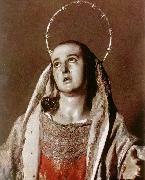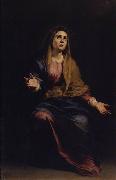Wholesale Oil Painting No Minimum |
|||||||||||
|
|
|||||||||||

|
|||||||||||
|
|
|
||||||||
SALZILLO, FranciscoSpanish sculptor (b. 1707, Murcia, d. 1783, Murcia). Spanish sculptor of Italian descent. He was trained by his father, Nicol Salzillo (1672-1727), a Neapolitan sculptor who had settled in Murcia, whose first documented work is dated 1700. Francisco also studied with the Jesuits and was taught drawing and sculpture by the cleric and painter Manuel Senchez ( fl 1731-9). He entered the Dominican Order in Murcia as a novice but left to take charge of his father's studio at the latter's death in 1727. Francisco was assisted by his brothers, Juan Antonio Salzillo and Patricio Salzillo, a priest, and by his sister, Ines Salzillo, who specialized in painting carved religious statues. In 1746 Francisco married Juana Vallejo Martenez, and in 1755 he was appointed escultor y modelista by the municipal government (ayuntamiento) and Inspector to the Inquisition for painting and sculpture in Murcia. In 1763 he established an academy |
||||||||
|
|
||||||||
Dolorosa
Dolorosa Painting ID:: 63017 |
1755 Painted wood Iglesia de Jesus, Murcia The mundane rhetoric in the works of Francisco Salzillo (also spelled Zarcillo) might be interpreted as the expression of a decadence of religious feeling; but in fact it springs from a deep-rooted faith. While yet a child, Francisco Salzillo entered a Dominican monastery as a novice. When he was twenty, he left the monastery to assume direction of the atelier of his father, Vincente Nicolas Salzillo, who died in 1727. Vincente Nicolas had come from Naples to settle in Murcia at the end of the 17th century. Undoubtedly, the breath of Italianism which he brought with him was instrumental in dispelling some of the gravity that the Spanish sculptors typically imparted to their religious works. The workshop of Francisco Salzillo, who was helped by his brothers, was amazingly productive; L?on Bermudez has counted 1,792 works definitely by the master's hand. Artist: SALZILLO, Francisco Painting Title: Dolorosa , 1701-1750 Painting Style: Spanish , sculpture Type: religious 1755 Painted wood Iglesia de Jesus, Murcia The mundane rhetoric in the works of Francisco Salzillo (also spelled Zarcillo) might be interpreted as the expression of a decadence of religious feeling; but in fact it springs from a deep-rooted faith. While yet a child, Francisco Salzillo entered a Dominican monastery as a novice. When he was twenty, he left the monastery to assume direction of the atelier of his father, Vincente Nicolas Salzillo, who died in 1727. Vincente Nicolas had come from Naples to settle in Murcia at the end of the 17th century. Undoubtedly, the breath of Italianism which he brought with him was instrumental in dispelling some of the gravity that the Spanish sculptors typically imparted to their religious works. The workshop of Francisco Salzillo, who was helped by his brothers, was amazingly productive; L?on Bermudez has counted 1,792 works definitely by the master's hand. Artist: SALZILLO, Francisco Painting Title: Dolorosa , 1701-1750 Painting Style: Spanish , sculpture Type: religious |
|||||||
|
|
||||||||
Bartolome Esteban MurilloSpanish 1618-1682 Bartolome Esteban Murillo Galleries Murillo began his art studies under Juan del Castillo in Seville. Murillo became familiar with Flemish painting; the great commercial importance of Seville at the time ensured that he was also subject to influences from other regions. His first works were influenced by Zurbaran, Jusepe de Ribera and Alonso Cano, and he shared their strongly realist approach. As his painting developed, his more important works evolved towards the polished style that suited the bourgeois and aristocratic tastes of the time, demonstrated especially in his Roman Catholic religious works. In 1642, at the age of 26 he moved to Madrid, where he most likely became familiar with the work of Velazquez, and would have seen the work of Venetian and Flemish masters in the royal collections; the rich colors and softly modeled forms of his subsequent work suggest these influences. He returned to Seville in 1645. In that year, he painted thirteen canvases for the monastery of St. Francisco el Grande in Seville which gave his reputation a well-deserved boost. Following the completion of a pair of pictures for the Seville Cathedral, he began to specialise in the themes that brought him his greatest successes, the Virgin and Child, and the Immaculate Conception. After another period in Madrid, from 1658 to 1660, he returned to Seville. Here he was one of the founders of the Academia de Bellas Artes (Academy of Art), sharing its direction, in 1660, with the architect, Francisco Herrera the Younger. This was his period of greatest activity, and he received numerous important commissions, among them the altarpieces for the Augustinian monastery, the paintings for Santa Mar??a la Blanca (completed in 1665), and others. |
||||||||
|
|
||||||||
|
|
Dolorosa
Dolorosa Painting ID:: 72786 |
166 X 107 cm., Museo de Bellas Artes de Sevilla
Date ca. 1665
cyf 166 X 107 cm., Museo de Bellas Artes de Sevilla Date ca. 1665 cyf |
||||||
|
|
||||||||
|
Bartolome Esteban Murillo Spanish 1618-1682 Bartolome Esteban Murillo Galleries Murillo began his art studies under Juan del Castillo in Seville. Murillo became familiar with Flemish painting; the great commercial importance of Seville at the time ensured that he was also subject to influences from other regions. His first works were influenced by Zurbaran, Jusepe de Ribera and Alonso Cano, and he shared their strongly realist approach. As his painting developed, his more important works evolved towards the polished style that suited the bourgeois and aristocratic tastes of the time, demonstrated especially in his Roman Catholic religious works. In 1642, at the age of 26 he moved to Madrid, where he most likely became familiar with the work of Velazquez, and would have seen the work of Venetian and Flemish masters in the royal collections; the rich colors and softly modeled forms of his subsequent work suggest these influences. He returned to Seville in 1645. In that year, he painted thirteen canvases for the monastery of St. Francisco el Grande in Seville which gave his reputation a well-deserved boost. Following the completion of a pair of pictures for the Seville Cathedral, he began to specialise in the themes that brought him his greatest successes, the Virgin and Child, and the Immaculate Conception. After another period in Madrid, from 1658 to 1660, he returned to Seville. Here he was one of the founders of the Academia de Bellas Artes (Academy of Art), sharing its direction, in 1660, with the architect, Francisco Herrera the Younger. This was his period of greatest activity, and he received numerous important commissions, among them the altarpieces for the Augustinian monastery, the paintings for Santa Mar??a la Blanca (completed in 1665), and others. Dolorosa 166 X 107 cm., Museo de Bellas Artes de Sevilla Date ca. 1665 cyf |
||||||||
|
|
||||||||
|
Prev Next
|
||||||||
|
|
||||||||
|
Related Paintings to Bartolome Esteban Murillo :. |
||||||||
|
|
||||||||
|
CONTACT US |


